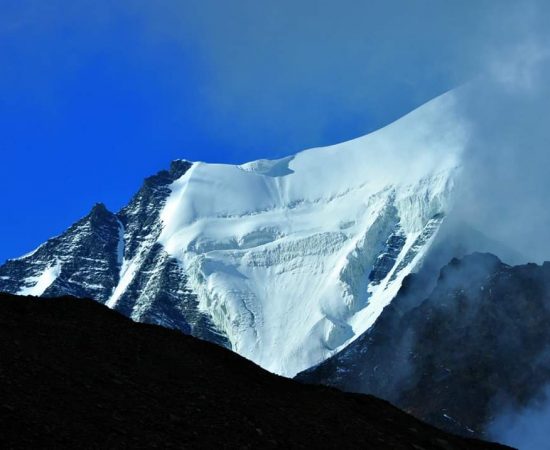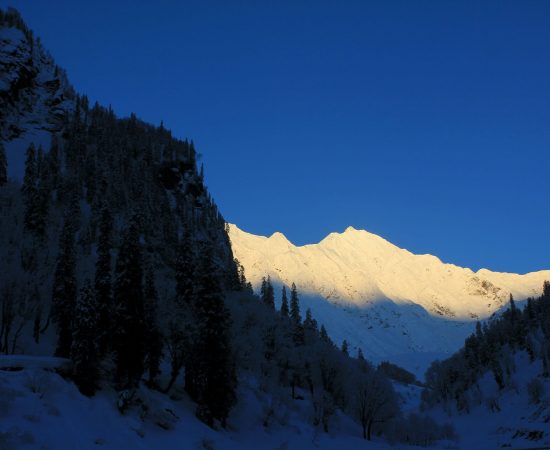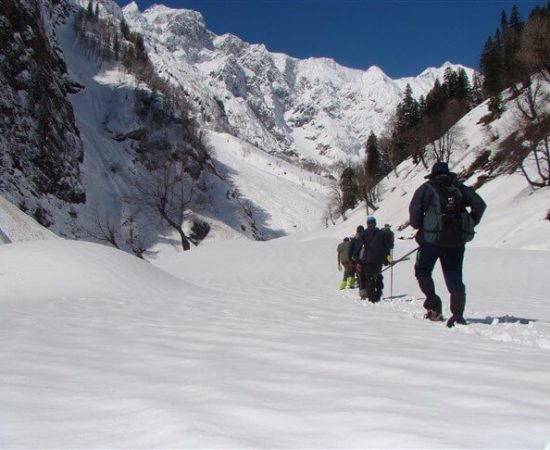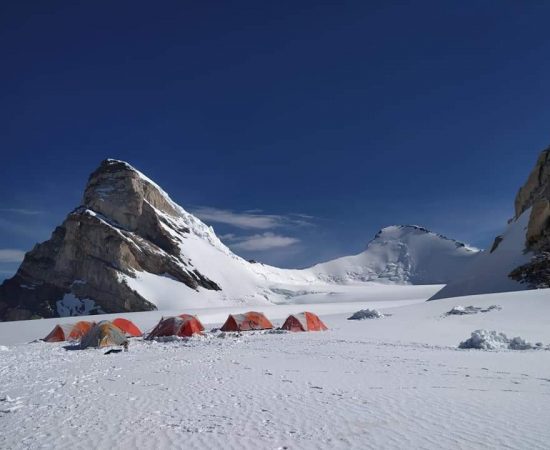Stok Kangri Peak Trek Expedition
Ladakh
Rated 4.9/5.0 on TripAdvisor. 550 Reviews


Key Highlights
- Altitude : 6123 mts
- Time : 8 Days - 7 Nights
- Region: Ladakh
- Best Time: June-September
- Distance: 40 Kms
- Grade: Moderate
Overview
Stok Kangri Peak Trek Expedition
One of the world's tallest trekkable peaks is Stok Kangri. Its height of 20,100 feet puts it above the tallest peak in Europe, Mt. Elbrus, which is 18,510 feet high. Slightly higher yet, at 19,340 feet, is the highest mountain in Africa, Mt. Kilimanjaro. It is without a doubt India's crown gem and surpasses two of the tallest mountains on two distinct continents. The summit day of the Stok Kangri journey is the largest and only difficulty, requiring you to endure sub-zero conditions, travel on a glacier for approximately 6-7 hours at night, and walk on the ridgeline for about two hours in order to reach the top. Although Stok Kangri doesn't need any prior technical knowledge, climbing is not for novices. The vista is worth the arduous climb to the top of Stok Kangri. From the Stok Summit, you can view both the Zanskar and Karakoram ranges. Every ardent trekker's desire is to participate in the Stok Kangri expedition, a once-in-a-lifetime journey. Stay on the page for additional facts, including a route map for the Stok Kangri Trek, a detailed schedule, information about the weather, images, videos, and reviews. Read the Stok Kangri hike blogs by scrolling to the bottom.
Cost Per Person
Key Highlights
- Altitude : 6123 mts
- Time : 8 Days - 7 Nights
- Region: Ladakh
- Best Time: June-September
- Distance: 40 Kms
- Grade: Moderate
Complete
Itinerary of Expedition
Before the walk, you will get information on the hotel you will be staying in. On the first day of the walk, check into your accommodation. Our trek leader will meet and greet you there. There will be a briefing session where all the information you need to climb Stok Kangri will be covered. Next, you will submit the medical form, undertaking form, and photocopy of your picture ID evidence that is necessary to get the permission. The remainder of the day is yours to adjust to the altitude and take in the local attractions of Leh.
At precisely 7 a.m., we'll start our acclimatisation walk after having tea at your hotel. We will either hike to Shanti Stupa or Shey Palace to gain altitude. Drink enough of water to stay hydrated and maintain regular body processes even at high altitudes. Following the acclimatisation walk, you have the remainder of the day to explore and do any last-minute preparations for the hike. We advise you to go to Khardung La since it is located at an altitude of 17,500 feet, which will benefit your body as you ascend.
After eating breakfast at the hotel this morning, we'll start our first day of hiking. We'll also have a packed lunch to keep us going. After that, we will get in our car and drive to Stok village, where our on foot tour will start. Beginning with a moderate incline, the hike begins. On the way, we'll even pass a couple stupas. According to Buddhist beliefs, it is lucky to always enter and exit from the left side of stupas. One hour into the hike, the path splits into two. One involves climbing to the top of a pass and then descending it again, while the other involves crossing the Stok River. Depending on the village's water level, we choose which path to follow. After an in-between lunch break, we'll ultimately arrive at our campground about 3 o'clock in the afternoon. At the campground, we will be given tea and refreshments before leaving for our acclimatisation walk. You should get up and move about as we ascend in height throughout the hike. Camping in Chang Ma for the night.
We'll do a little light stretching to warm up for our day after morning tea and getting ready. Breakfast is followed by our walk. We will reach the summit of Chang Ma pass after a hard early portion of the trek. We will next descend and merge with the Stok river path. Due to the hue of the soil that dissolves in it, the river has a mixture of purple and brown tones. The riverside path splits into two as we go. One will take us to Mankormo, while the other will lead us to the Rumbak Valley. Despite the short distance of the trip today, we like to increase the altitude gradually so that our bodies can adapt to the higher altitude more easily. Today at the Mankormo campground, a cooked lunch will be provided for us. Following tea, we will go on our acclimatisation hike. Camping in Mankormo for the night.
Immediately after our morning warm-up session, we will depart from our campground. The path will follow the Stok River, and in order to continue climbing the mountain, we will often have to cross it. Due to the gradient and altitude, the last portion of the walk requires a lot of energy and is steep. During the hike, you may hear or see marmots and pikas in the region around the climb. When we get to the campground, we'll set up tent and have lunch. In the evening, we will set out for our acclimatisation hike to the flag point after tea and snacks. You can see Stok Kangri clearly and directly in front of you from there. After getting a good look at the Great Mountain, return to the campground for supper and some downtime. Stay the night in Stok Kangri Base Camp.
This day is set out for recuperation, acclimatisation, and practising the skills you'll need to use to scale the summit. We'll begin each day with some breathing exercises called pranayamas. We'll start our workout when breakfast is over. You will first get your equipment, which includes an ice axe, crampons, snow boots, and a helmet. Then we'll go on to the more challenging slopes where we'll practise skills like roping up, going up and down snow slopes, and stopping ourselves if we fall. We'll go back and have a quick lunch. Because the summit push will begin late at night and you need to give your all, try to get as much rest as you can. You will get a wake-up call for the evening at nine o'clock and be served porridge, Maggie, and coffee before departing for the mountain.
We depart the previous evening at eleven; the day of counting has already started. As we approach the dining tent, everyone is equipped and ready to go for the peak. Before leaving for the peak, the trip guide will provide his parting motivational and instructional remarks after a brief breakfast of Maggie, oatmeal, and coffee. The first portion of the route is the same as the one we used to acclimatise and ascend the steep, dusty, rocky terrain to the flag point. The real methods needed to successfully scale the mountain start to emerge at this point. We go up the path and climb a 60-degree slope until, after some cautious navigation, we arrive at the location that served as the original Advance Base camp for the summit attempt. After a little rest, we'll continue on our way to the Stok Glacier. You must leap over the little crevasses that are made of hard ice on this. As we continue on, the most challenging section of the walk begins: the 60-degree slope that we must zigzag and ascend. You will be able to complete this challenge if you maintain your energy and drive during the lengthy, difficult climbing process. We will reach the shoulder of the Stok Kangri, which will welcome us with prayer flags, after three arduous hours of ascending along the zigzag trail. From this point on, the path becomes very difficult, requiring careful route-finding on the jagged crest. It takes two hours to traverse the ridgeline as the top draws near. The top is covered with flags of prayer. On a clear day, you can see the Karakoram mountain range and, with any luck, Mt. K2. We return to Base camp by the same path. Dinner is served; afterwards, take a much-needed nap before returning to Leh.
Retracing our steps to the mountains, we return to Stok village along the same path. From there, our cars will transport us back to the city and to our hotel, where we can relax with a warm shower and a comfortable bed after a long day of strenuous hiking. Celebrate the end of the walk with your other colleagues and the trek leader in the evening. You will have many memories and lessons to reflect on.
Enquiry For Group Bookings
Guidelines
➽ Preparation for Expedition
As you know every mountainous excursion demands a precise planning, a planning with adequate pliability of observing and tackling situations, held all as by overcoming mind body and soul throughout the incredible Himalayan journey.
So here are some aspects regarding Stock Kangri Peak Trek Expedition preparation:
⦿ Physically – A trek demands physical endurance, to prepare for each trek you should work out a month before joining a program. Build up the adequate strength in your legs by running and exercising every day to boost up your endurance. Stop smoking and boost your lungs doing breathing exercises at routine basis two times a day, which will help acclimatize the conditions while being resilient on the trek. Take active part in outdoor games, Yoga and any other cardiac exercises.
⦿ Mentally – Mental preparation is key, equally as important as physical training requisite for a trek. Before joining any trek take pleasure in your daily routines, eat well, take rest properly and relax. Do not stress your mind by unnecessary predictions about the trek. Be with your best friends to get motivated and relax your mind. Because pre trek assumptions are not worthy because once you join the trek and meet with rest of the pack will bring encouragement and excitement. The mental preparedness will build through the entire trek conditions. And the physical drawbacks will affect the mind. So pay close attention to various parts of the body and consciously let them loosen up as you trek. When you trek try to relax your body, especially your hips. If you’re on a winding downhill trail or on a panicking slant, think of each step as part of a simple dance and enjoy the natural rhythms that the terrain and your body can find together cautiously. Experiment with different ways of walking as a way of finding enjoyment beyond the goal of reaching a destination. The main key to stay mentally fit is to enjoy the route and not to pressurize the mind.
Guidelines
➽ Things to Carry
- Good Trekking Boots: You need sturdy trekking boots with supportive high ankles. Don't bring your running shoes. U can carry extra floaters/flip flops also.
- Wear warm clothing, such three-layer coats, fleece upper, hollow fill or down-filled jackets. Carry full-sleeved T-shirt. Carry cotton hiking trek pants and warm pant for your lower body. Never bring shorts or jeans on a hike.
- Take top and bottom thermals with you.
- Quick dry towel with light weight and Personal toiletries. Suns cream lotion, sanitizer, tooth brush ad toothpaste, lip balm and antibacterial powder.
- Socks: Bring two pairs of regular socks and two pair of wool socks for wearing at night.
- A head torch is required.
- Sunglasses/ Goggle: UV-protected sunglasses are necessary to protect against sunlight and Snow Mountain.
- There should also be a woolen cap / balaclava, cap, neck gaiter cum face mask and warm fleece and waterproof summit gloves since it will be chilly. Keep waterproof gloves on hand since they become wet in the snow.
- Everyone taking part in the activity should have their own lunchbox, spoon, mug and water bottle/ hydration pack of 2 ltr.
- Raincoats/ponchos: Since snowfall and rain are frequent at high elevations, it is important to have one on hand so as to avoid getting wet.
- Trekking bag of 75 ltr with rain cover.
- Walking stick.
- Personal first aid box. Emergency ration, energy bars, dry fruit, electoral/Ors
- Personal technical gears list of mountaineering (on rent basis available)
- Climbing boot, Crampon, Sleeping bag (optional), Ice axe, seat harness, Rope and tape sling, helmet, Summit gloves, Gaiters, Carabineers 2 no (screw), figure of eight/descendor, Zumar (Ascendor),
- Required Documents:
a) Registration Form
b) Medical Certificate (signed by a licensed MBBS physician)
c) NOC form (completed by the trekker)
d) 2 passport-size photos
e) ID Proof photo (not PAN)
f) Basic Mountaineering Course certificate.
g) Insurance upto 5 lac..
Guidelines
➽ How to Reach
The best mode of transportation is airplanes:
The only way to get to Ladakh is by flight after the roads to the high passes are blocked for the winter season due to snow. The Manali-Leh and Srinagar-Leh roads are often shut by October-November and November-December, respectively. Throughout the winter, a number of airlines provide frequent flights to Leh. The major goal is Delhi. From Delhi to Leh, there is one flight every day. All three airlines provide flights between New Delhi and Leh: Jet Airways, Air India, and Go Air.
Because rates have a tendency to increase after a given length of time, reservations should be made well in advance.
➽ Trip Cost Includes
- Mountaineering (Instructor/guide) services provided by a highly trained, professional, and qualified Himalayan Adventure Trips staff.
- Certified local guide with extensive familiarity of the area.
- Climbing provides only vegetarian food (breakfast, lunch, and dinner).
- Staff include chefs, cooks, and helpers.
- High Altitude Force, Low Altitude Force, Porters, Mules for Common Equipment (Rations, Tents, Utensils, Central Climbing Equipment, etc.)
- Tents (to be shared), sleeping bags, air mattresses, and air pads are included. Inner
- We offer twin-share accommodations in dome, alpine, and high-altitude tents on all of our treks and expeditions. All necessary camping equipment, including air mattresses, a shelter for cooking and eating, a table and chairs, a stool, and more, would be supplied.
- Someone who can carry heavy items, set up high camps, repair ropes, etc. at high altitudes.
- Assistance from Guide All the Way to the Top
- High-altitude butane gas cooker
- The only meal offered at the hotel will be breakfast. All meals while on the walk will be supplied for you. Indian, Chinese, and Continental cuisines, all freshly cooked, will be on the menu.
- Tin-packaged food is what we'll eat at high altitude.
- A standard first aid kit with oxygen masks for the patient.
- Camping fees, wildlife fees, and forest permits.
- Taxes imposed by the state.
➽ Trip cost Excludes
- Climbers may hire individual porters to carry their gear.
- Airport transportation costs
- Expenses for carrying still/video cameras etc.
- Irregular/Personal costs, such as laundry, phone calls, and gratuities.
- Climbing equipment such as ropes, pitons, snow bars, crabs, etc.
- Your own personal mountaineering equipment and clothes, as well as any specialised foods you may need
- Inner Line Permit.
- Health coverage or the price of a rescue mission
- Expenditures of a more personal character (such as booze, soda, bottled water, mineral water, canned or bottled drinks, candy, canned or packaged dried fruits, etc.)
- Provisions/food to or from the starting point of the trek.
- Any expenses that are incurred as a result of natural disasters, human error, or other unforeseeable occurrences.
- Protect your trip with a travel insurance policy.
- Authorization, licensing, and enlistment with the IMF.
- Payment for Liaison Officer (included for foreign expedition only)
- GST of 5%.
Guidelines
➽ Special Casual Leaves
Government employee can avail the benefit of special casual leave when u join us for a trekking expedition. As per the rule of the pay commission, special casual leave can be availed for up to 30 days in a calendar years for trekking and mountaineering expeditions through a register organization. Himalayan adventure trips are a register adventure tour operator register with Indian mountaineering foundation and Himachal Pradesh tourism. Candidates have to apply for leave at least 30 days before the trek/expedition start.
Testimonials
➽ Provided By The Customers
Everything about our visit to Prashar lake was better than we could have imagined. From our initial contact with Himalayan Adventure Trips, we felt their genuine interest in learning about our group's goals and expectations, and our travels with them reinforced at every turn that they not only understood our requirements but also have the acute skill and expertise to achieve them. Having already had such a wonderful experience with this firm, I will be promoting a trek to Prashar lake to all my friends who share my passion for hiking and will specifically recommend that they work with this outfit. Absolutely fantastic; I have nothing but praise for it.
How useful was this post?
Click on a star to rate it!
Average rating 0 / 5. Vote count: 0
No votes so far! Be the first to rate this post.






